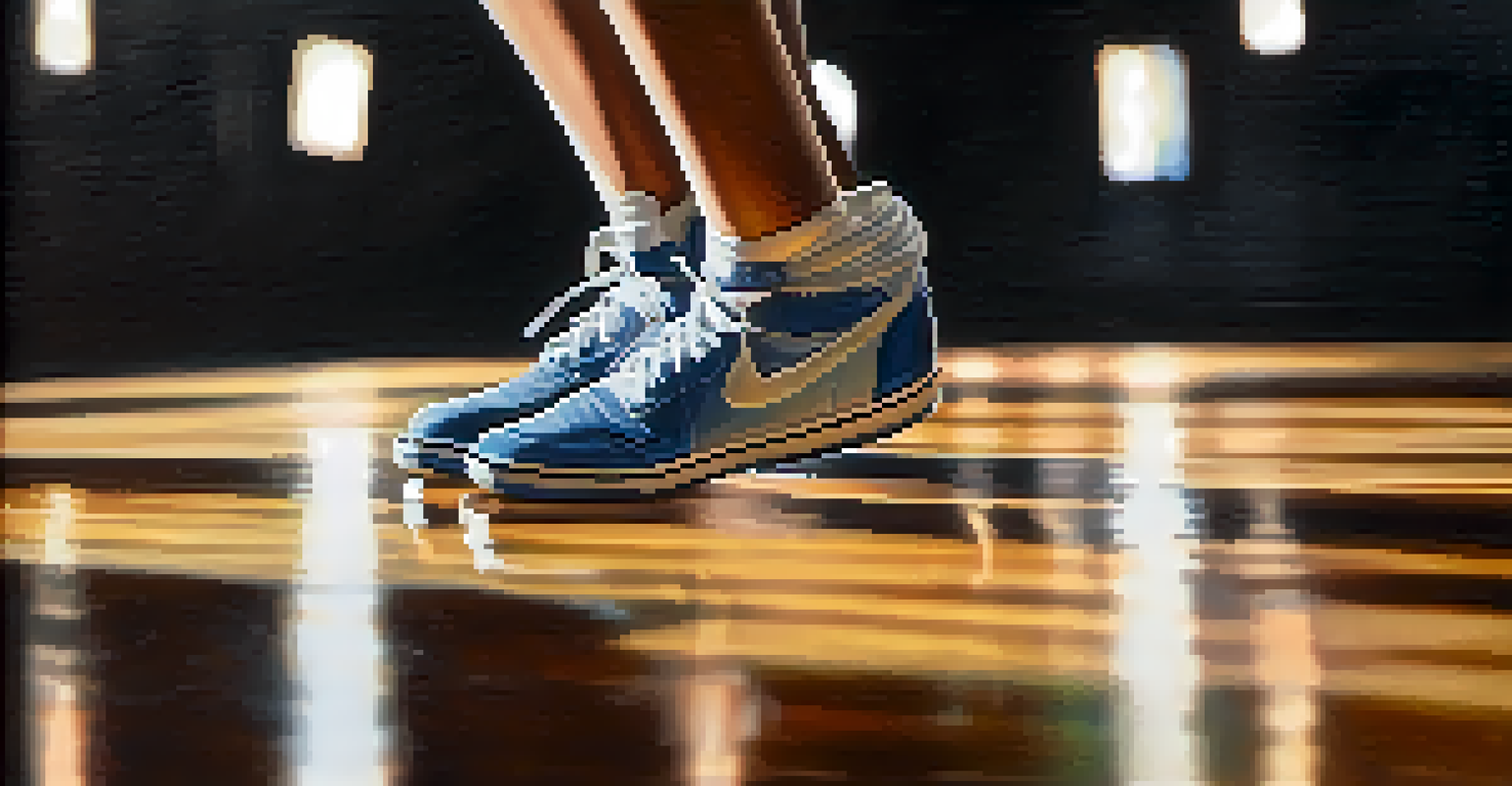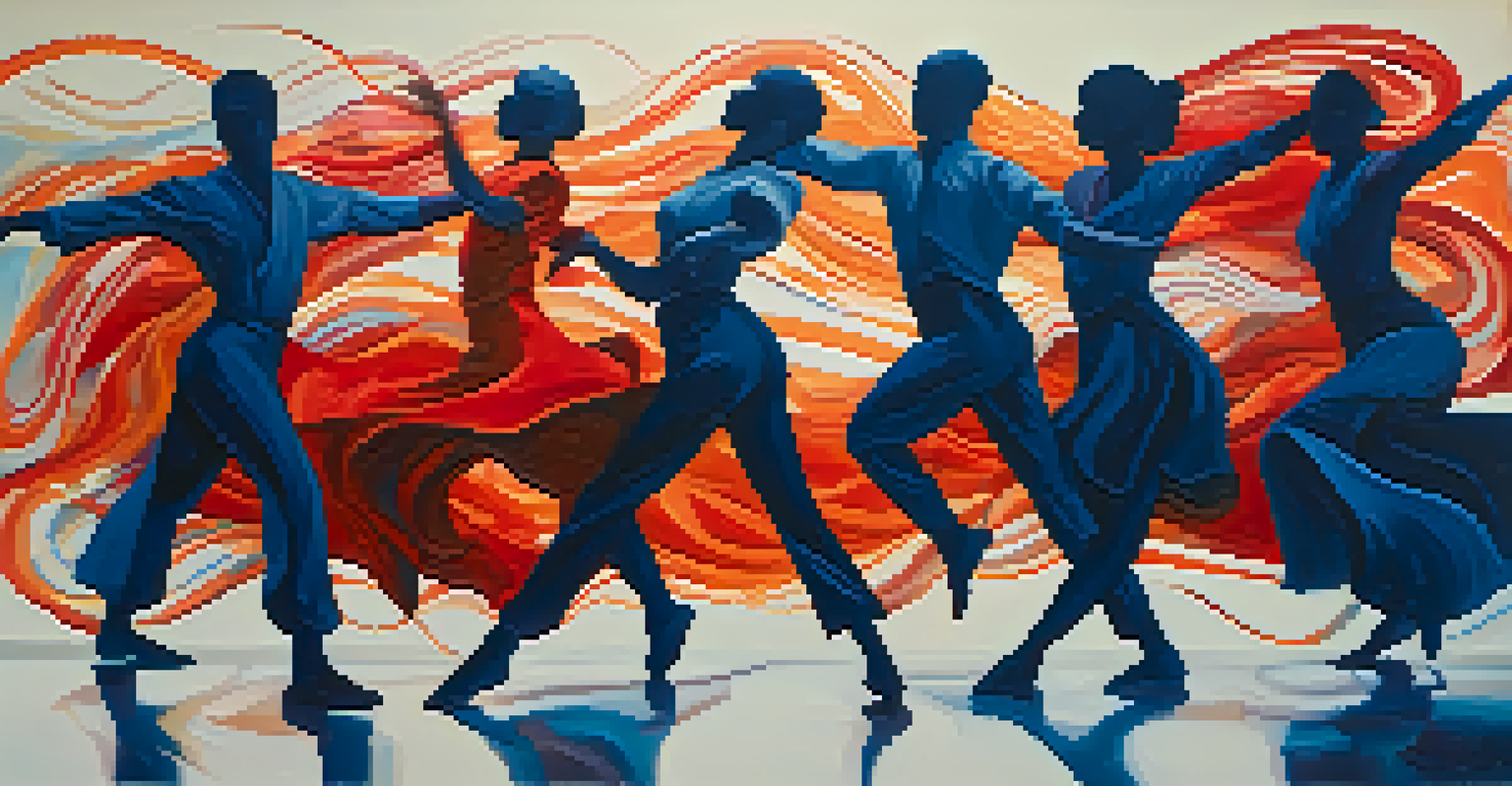Contemporary Dance: Blending Techniques from Various Styles

Understanding Contemporary Dance: A Unique Art Form
Contemporary dance is an innovative art form that emerged in the mid-20th century, breaking away from traditional dance styles. It embraces a variety of techniques, allowing for personal expression and creativity. This dance genre often reflects current societal issues, making it a powerful medium for storytelling and connection.
Dance is the hidden language of the soul.
Unlike classical ballet, which adheres to strict techniques and forms, contemporary dance encourages improvisation and fluidity. Dancers draw inspiration from various styles, such as jazz, hip hop, and even ballet, creating a rich tapestry of movement. This blending of techniques allows dancers to explore their individuality while still being part of a collective.
As contemporary dance continues to evolve, it incorporates elements from theater, visual arts, and even technology. This dynamic nature makes it accessible to a broader audience, inviting people from all walks of life to engage with the performance. Ultimately, contemporary dance serves as a canvas for artists to express their thoughts and emotions in a uniquely captivating way.
The Role of Technique in Contemporary Dance
Technique is the backbone of any dance style, and contemporary dance is no exception. Dancers often train in multiple forms, mastering the fundamentals before breaking the rules. Whether it's the precision of ballet or the rhythm of hip hop, these techniques provide a strong foundation for creativity.

Incorporating various techniques allows for a greater range of movement and expression. For instance, a dancer might use a ballet-inspired pirouette followed by a grounded hip hop step, showcasing the versatility of their training. This fusion not only enhances the performance but also captivates the audience, who can see the seamless transitions between styles.
Contemporary Dance's Unique Blend
Contemporary dance creatively fuses various styles, allowing dancers to express their individuality while honoring traditional techniques.
Moreover, the emphasis on technique in contemporary dance encourages physical awareness and control. Dancers learn to listen to their bodies, understanding how to move efficiently and safely. This deep connection to their physicality enables them to push boundaries and explore new ways of expressing themselves.
The Influence of Jazz on Contemporary Dance
Jazz dance has significantly shaped contemporary dance, bringing its unique flair and energy. Originating in African American communities, jazz is characterized by its lively rhythms and improvisational style. Contemporary dancers often incorporate jazz elements, such as syncopated movements and dynamic expression, to add depth to their performances.
The body says what words cannot.
The use of jazz techniques allows dancers to explore their musicality, responding to the beat in innovative ways. For instance, a contemporary piece might feature sharp, staccato movements interspersed with smooth, flowing transitions, creating a captivating contrast. This blend of styles not only showcases the dancer's skill but also engages the audience on a deeper level.
Additionally, jazz's emphasis on personal expression aligns perfectly with contemporary dance's core values. Dancers are encouraged to infuse their personalities and emotions into their movements, making each performance unique. This synergy between jazz and contemporary dance fosters a vibrant environment where creativity can thrive.
Exploring the Impact of Hip Hop in Contemporary Dance
Hip hop has become a driving force in contemporary dance, influencing its energy and style. With its roots in street culture, hip hop emphasizes rhythm, attitude, and individuality. Dancers often integrate hip hop moves into contemporary choreography, adding a layer of authenticity and relatability to their performances.
The incorporation of hip hop elements allows for a more dynamic range of movement, encouraging dancers to experiment with their bodies. From popping and locking to breakdancing, these techniques can be adapted to fit the emotional tone of a contemporary piece. This versatility makes hip hop an invaluable asset to the contemporary dance repertoire.
Emotional Expression is Key
The emphasis on emotional storytelling in contemporary dance fosters deeper connections between performers and audiences.
Moreover, the fusion of hip hop and contemporary dance helps bridge generational gaps, appealing to diverse audiences. It creates a space where different cultural expressions can coexist, fostering understanding and appreciation for various dance forms. As a result, contemporary dance continues to evolve, reflecting the vibrant world we live in.
The Influence of Ballet in Modern Contemporary Dance
Ballet has long been regarded as the foundation of many dance styles, and its influence on contemporary dance is undeniable. Many contemporary dancers start their training in ballet, gaining strength, flexibility, and discipline. These skills serve them well as they explore more fluid and expressive movement styles.
Incorporating ballet techniques allows contemporary dancers to achieve a sense of grace and precision. Fluid leg extensions and controlled jumps can enhance a performance, adding layers of beauty and elegance. This balance of strength and softness creates a visually stunning experience for the audience.
Furthermore, the melding of ballet with contemporary dance encourages exploration beyond traditional forms. Dancers can experiment with new ways of interpreting classical movements, pushing boundaries and challenging norms. This creative interplay enriches the dance landscape, inviting both dancers and audiences to appreciate the art form's evolution.
Emphasizing Emotional Expression in Contemporary Dance
One of the hallmarks of contemporary dance is its focus on emotional expression. Dancers are encouraged to convey their feelings through movement, making each performance a personal narrative. This emphasis on emotion allows audiences to connect with the dancers on a deeper level, often evoking powerful reactions.
Choreographers often create pieces that explore themes of love, loss, and identity, providing a canvas for dancers to share their stories. For instance, a contemporary performance might depict the struggles of self-discovery, with each movement symbolizing a different facet of the journey. This storytelling aspect adds layers of meaning to the choreography.
Innovations Shape Dance's Future
Technological advancements and inclusivity are transforming contemporary dance, making it more accessible and diverse than ever.
Moreover, the emotional depth of contemporary dance encourages vulnerability, inviting dancers to be their authentic selves. This openness not only enhances the performance but also fosters a sense of community among dancers and audiences alike. Ultimately, the emotional core of contemporary dance is what makes it such a compelling and transformative experience.
The Future of Contemporary Dance: Innovations and Trends
As contemporary dance continues to evolve, new trends and innovations are emerging. The integration of technology, such as virtual reality and multimedia, is reshaping the way performances are created and experienced. This fusion of art and technology offers exciting opportunities for choreographers to push creative boundaries.
Moreover, contemporary dance is increasingly embracing inclusivity, welcoming diverse voices and perspectives. Dance companies are recognizing the importance of representation, leading to the creation of pieces that reflect a wide range of experiences. This shift enriches the art form and fosters a sense of belonging within the dance community.

Additionally, the rise of social media has transformed how contemporary dance is shared and consumed. Platforms like Instagram and TikTok allow dancers to showcase their work to a global audience, encouraging collaboration and inspiration across borders. As a result, contemporary dance is becoming more accessible than ever, inviting new generations to explore this vibrant art form.
Conclusion: The Beauty of Blending Dance Styles
Contemporary dance stands as a testament to the beauty of blending various dance styles. By drawing from diverse techniques, dancers can express their individuality while still honoring the traditions that came before them. This fusion creates a rich and dynamic art form that resonates with audiences around the globe.
As contemporary dance continues to evolve, it remains a powerful tool for storytelling and emotional expression. The incorporation of styles like jazz, hip hop, and ballet enriches the performances, showcasing the versatility and creativity of dancers. In this ever-changing landscape, the possibilities are endless.
Ultimately, contemporary dance invites us to celebrate our shared humanity through movement. It encourages us to embrace our differences while finding common ground in the rhythm of life. This beautiful art form is a reminder that, no matter our backgrounds, we can all come together to create something truly extraordinary.